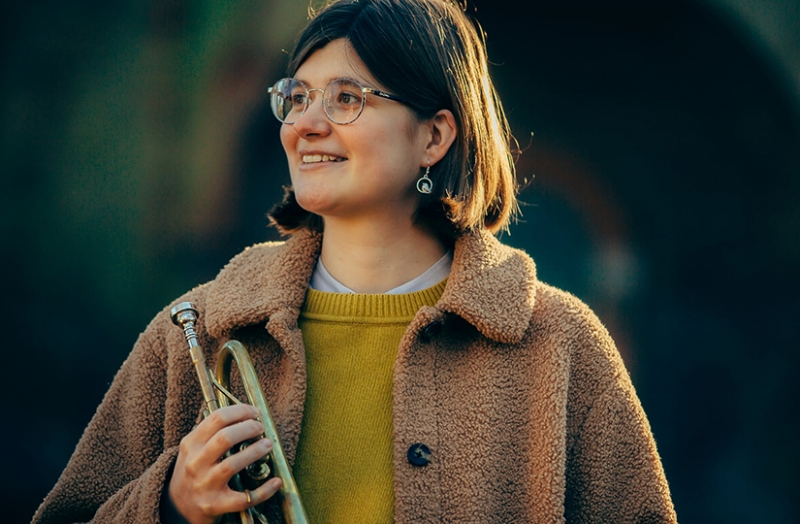
Nearly 50 years after Ellington’s death, Duke’s music still continues to inspire young musicians. One of them is Laura Jurd. For those of you who haven’t heard about her, she is a British award-winning trumpet player, composer and bandleader. Very active on the UK scene, Laura has developed a reputation as one of the most creative young musician in recent years.
There are many similarities between Ellington’s and Jurd’s music. Just as the blues is always a fundamental element in Ellington’s music, Jurd likewise draws on folk music from her heritage. She doesn’t accept boundaries in music either, and her music reaches far beyond so called jazz music.
If you listen through the 8 albums or so she has made so far, and the many recordings available on YouTube, you will find several pieces related to Ellington. One of them is Billy Strayhorn’s composition Absinthe from 1963. She recorded it for the album To the Earth, released in 2020, with her regular quartet Dinosaur, together with 6 of her own compositions.
This new interpretation of this relatively obscure Strayhorn tune, is done with much respect to the original, but at the same time, the four musicians manages to give it a modern touch. It’s also quite remarkable how well Strayhorn’s tune fits in with Jurd’s own compositions.
Like Absinthe, the next track also originates from the Afro Bossa album. It is Ellington’s own composition Purple Gazelle. Jurd recorded a duo version for YouTube in 2020 with drummer Corrie Dick, also af member of the quartet Dinosaur.
There are many similarities between Jurd’s playing and the style of the Ellington trumpets. When you listen, you will notice a lot of growl and plunger work, witch often reminds me of Ray Nance. She also does valve effects, like squeezing the note and making tremolos and trills using alternative fingering, much like Rex Steward did (think of Frantic Fantasy for example).
Like Duke’s musicians, Laura also likes to invent new sounds on the instrument. On Purple Gazelle you will hear a short section (0:43) where she plays with a buzzing sound. This is done by inserting a kazoo into the bell. I have never heard anyone else do that.
In 2021, she made a solo recording of Absinthe for YouTube. Here you can hear her play some pedal notes. Every trumpet player can do that, but it’s rarely used as anything more than a technical exercise. Here she implies these low notes to good effect, with good sound and intonation, and so did Rex Steward occasionally back in the days (think of the cadenza from Boy meets horn for example.)
The last example is Jurd’s own composition Jump Cut Shuffle, written for the Ligeti String Quartet in 2016, and included on the album Stepping Back, Jumping In, released in 2019. The piece is inspired by Ellington and Strayhorn’s The Queen’s Suite from 1959. Here is a short video by Laura explaining the idea behind the piece.
As Jurd states in the video, it is not an arrangement of The Queen’s Suite. Instead, she has taken small sections from Ellington and Strayhorn’s work and used them as a starting point for her own composition. Although not an arrangement, there are several easily recognizable bits of Ellingtonia in the piece. The most obvious, is probably Paul Gonsalves’ break heard several times during the Northern Lights movement. It is first presented solo in the viola (1:35), and later as a canon between all four strings (5:41). The beginning of Lightning Bugs and Frogs is also clearly heard as a cannon (1:07), played pizzicato by all four string players. There are several others. Try for yourself and see how many you can find.
And if you haven’t had enough Laura Jurd at this point, i recommend listening to her latest album, released this september, entitled The Big Friendly Album.
Recommended albums by Laura Jurd:
- Laura Jurd: The Big Friendly Album (Big Friendly Records, 2022)
- Dinosaur: To The Earth (Edition Records, 2020)
- Laura Jurd: Human Spirit (Chaos Collective, 2014)
Webpage: https://www.laurajurd.com/